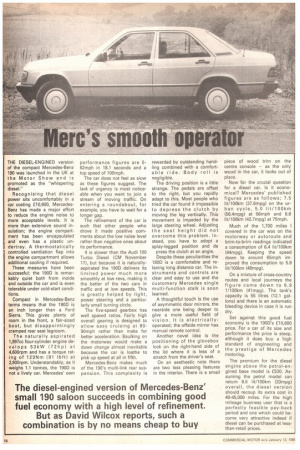erc s smooth opera or
Page 58

If you've noticed an error in this article please click here to report it so we can fix it.
THE DIESEL-ENGINED version of the compact Mercedes-Benz 190 was launched in the UK at the Motor Show and is promoted as the "whispering diesel."
Recognising that diesel power sits uncomfortably in a car costing £10,600, MercedesBenz has made a major effort to reduce the engine noise to more acceptable levels. It is more than extensive sound insulation; the engine compartment has been encapsulated and even has a plastic undertray. A thermostatically controlled ventilation flap into the engine compartment allows additional cooling if required.
These measures have been successful; the 190D is remarkably quiet both from inside and outside the car and is even tolerable under cold-start conditions.
Compact in Mercedes-Benz terms means that the 190D is an inch longer than a Ford Sierra. This gives plenty of room in the front, a fair-sized boot, but disappointingly cramped rear seat legroom.
The naturally aspirated 1,997cc four-cylinder engine develops 53kW (72hp) at 4,600rpm and has a torque rating of 123Nm (91 lbft) at 2,800rpm. Understandably, as it weighs 1.1 tonnes, the 190D is not a lively car. Mercedes' own performance figures are 062mph in 18.1 seconds and a top speed of 100mph.
The car does not feel as slow as these figures suggest. The lack of urgency is most noticeable when you want to join a stream of moving traffic. On entering a roundabout, for example, you have to wait for a longer gap.
The refinement of the car is such that other people who drove it made positive comments about the low noise level rather than negative ones about its performance.
It is slower than the Audi 100 Turbo Diesel (CM November 17), but because it is naturallyaspirated the 190D delivers its limited power much more smoothly at low revs, making it the better of the two cars in traffic and at low speeds. This is greatly helped by light, power steering and a particularly small turning circle.
The five-speed gearbox has well spaced ratios. Fairly high overall gearing is designed to allow easy cruising at 8090mph rather than make for better acceleration. Baulking on the motorway would make a down change almost inevitable because the car is loathe to pick up speed at all in fifth.
Mercedes-Benz makes much of the 190's multi-link rear suspension. This complexity is rewarded by outstanding handling combined with a comfortable ride. Body roll is negligible.
The driving position is a little strange. The pedals are offset to the right, but you rapidly adapt to this. Most people who tried the car found it impossible to depress the clutch by moving the leg vertically. This movement is impeded by the large steering wheel. Adjusting the seat height did not overcome this problem. Instead, you have to adopt a splay-legged position and de press the clutch at an angle.
Despite these peculiarities the 190D is a comfortable and relaxing long distance car. The instruments and controls are clear and easy to use and the customery Mercedes single multi-function stalk is soon learned.
A thoughtful touch is the use of asymmetric door mirrors, the nearside one being deeper to give a more useful field of vision. It is electricallyoperated; the offside mirror has manual remote control.
Another novel idea is the positioning of the glovebox lock on the right-hand side of the lid where it is less of a stretch from the driver's seat. On an aesthestic note there are two less pleasing features in the interior. There is a small piece of wood trim on the centre console — as the only wood in the car, it looks out of place.
Now for the crucial question for a diesel car. Is it economical? Mercedes' published figures are as follows; 7.5 lit/100km (37.6mpg) on the urban cycle, 5.0 lit/100km (56.4mpg) at 56mph and 6.6 lit/100km (42.7mpg) at 75mph.
Much of the 1,700 miles I covered in the car was on the motorway or autoroute and brim-to-brim readings indicated a consumption of 6.4 lit/100km (44mpg). Keeping the speed down to around 65mph improved the consumption to 5.9 lit/100km (48mpg).
On a mixture of cross-country routes and local journeys the figure came down to 6.9 1/100km (41mpg). The tank's capacity is 55 litres (12.1 gallons) and there is an automatic bleeding device in case it is run dry.
Set against this good fuel economy is the 190D's £10,600 price. For a car of its size and performance the price is steep, although it does buy a high standard of engineering and the prestige of Mercedes motoring.
The premium for the diesel engine above the petrol-engined base model is £530. Assuming the petrol model can return 8.6 lit/100km (33mpg) overall, the diesel version should recoup its extra cost in 40-45,000 miles. For the high mileage business user that is a perfectly feasible pay-back period and one which could become very attractive indeed if diesel can be purchased at lessthan-retail prices.
























































































